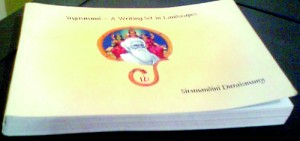In the steps of a young boy who became the Sage of Jaffna
View(s):The Yogaswami Trust celebrated Swami’s 50th Mahasamadhi, (death anniversary) with traditional puja and aaradhana in all its centres. A special feature of this programme was the launch of an unusual book, “Yogaswami – a Writing Set in Landscapes,” by Sivanandini Duraiswamy. The book is beautifully laid out- the biographical sketches have illustrations relating to young Sathasivan who blossomed out as Yogaswami – the Sage of Jaffna. There are pictures, drawings and sketches relating to his life, teachings and writings, copied with permission, or drawings/sketches done by her or photographs taken by her to illustrate a point. The writings of poetry – Natchintanai, essentially spiritual are beautifully illustrated as white flowers depicting purity in its true form.
One could see that a great deal of research has been done and the story is laid against the natural background in the author’s elegant style.
Yogaswami as most older Hindus would know was indeed a rare personality – the Sage of Jaffna who lived in the last century – a kind shepherd guiding his flock in their daily life. The author’s husband, Yogendra writes – “ On 23rd of May 1872 was born in Maviddapuram, Jaffna, a man who became a living legend in Sri Lanka. Clad in only a plain white verti he led a simple life moving among people, sharing in their concerns and cares and guiding them to lead a righteous life. He was neither a priest nor a preacher, but a highly evolved being who radiated love and compassion….” (His article is at the end of the book together with that of the author.)
He was named Sathasivan. One could see that the young boy even as a child was – spiritually inclined and the author speaks of finding it difficult to narrate/write the story of such a one whose childhood is underscored by his inherent spiritual instincts.
When asked about his young days Sathasivan would say, “I am always as I am now! The way I am now, I have always been.” It is here that the author said that she found it rather difficult to capture the story of the young man deeply intertwined with atmic spirituality. In this context, the young boy in describing his childhood speaks of the Atman – the eternal Self and not the physical body – a Vedantic expression of the eternal Self in man.
However, the author weaves the young boy’s inner spiritual inclinations into his mainstream life which in his younger years made him a ‘Soul in conflict.’ In assuaging this inner conflict, the author narrates the story of him going to the Nallur Temple with his mother where we see him worshipping Lord Mutugan, watching the pujas and absorbing the overflowing spirituality made alive by the chanting of mantras and the Nagaswara music.
The author next takes us to Irranamadu in Kilinochchi. In describing the story, the author herself had gone to Irranamadu and taken several pictures to give the story a natural setting with the sluices gates opened and the water pouring down fast. Kilinochchi is where young Sathasivan besides his work during the day prepares himself for sannyasam – life of an renunciate. The rigour of preparation is beautifully told by the author in the words – “he lived like an ascetic leading an austere life, often meditating all night long demanding utter simplicity and purity of himself.” These were his sadhana years leading him to his Guru Chellappaswami – “There at the site of the temple car under the shade of the Vilva tree, Sathasivan saw a frail yet striking personality whom he had been searching for – this was Chellappaswami. And Chelppaswami in turn recognized a would-be jnani in Sathasivan.
The Guru initially teaches him spiritual aphorisms namely – “Summa iru,” be Still; “Eppaavo mudintha kaariyam,” – it was all finished long ago; “Naam ariyom,” we know not; “Muluthum unmai,” all is truth; “Oru pollaapum illai,” there is no one wrong thing. These were the essence of his teaching.
The essence of his teaching was – “Yaaradaa ni,” a phrase that transfixed him, This phrase translates as “Who are you?” Yes ‘Who am I.’ Young Sathasivan who has now been initiated into Sannyasam and becoming Yogaswami, would weave this concept into his teachings and it is indeed the question we all have to ask ourselves and find the answer.
In the Bhagavad Gita, Bhagavan Krishna says. “He is not born. Nor does he ever die. After having been, he again ceases to be – unborn, eternal, changeless and ancient, he does not die when the body dies.” From this we could glean that we are the atman and Swami’s words as a child was the Vedantic expression of the truth answering the question ‘Who am I?’
“Writing Swami’s story was certainly not easy. And though the idea of writing the story was my revered husband’s wish, the mantle of writing had to fall on me as Swami’s would himself say “Eppavo mudintha kaariyam,” – the decision had been taken long ago!,” Mrs. Duraiswamy said.
“And it has been wonderful for me to write this story in my own style – “Yogaswami – A Writing Set in Landscapes.” It should have been worded – A Biography set in Landscapes. But then “Who am I to write Pujya Yogaswami’s biography?” she says.
| Book facts
“Yogaswami – A Writing Set in Landscapes,” by Sivanandini Duraiswamy. Reviewed by a senior devotee |


